Data Analysis and Forecasting Report - Numeracy, LSC, Suffolk
VerifiedAdded on 2023/03/21
|11
|1411
|37
Report
AI Summary
This report analyzes weather data for London in May 2017, covering temperature and humidity. It includes a tabular representation of the data, time series charts to identify trends, and a scatter plot to explore the relationship between temperature and humidity. Descriptive statistics such as mean, median, mode, range, and standard deviation are calculated for both variables. A simple regression model is then developed to forecast future temperature values, with calculations for days 15 and 23 provided. The report concludes with references to relevant research methods and statistical analysis resources. Desklib provides students access to similar solved assignments and past papers.
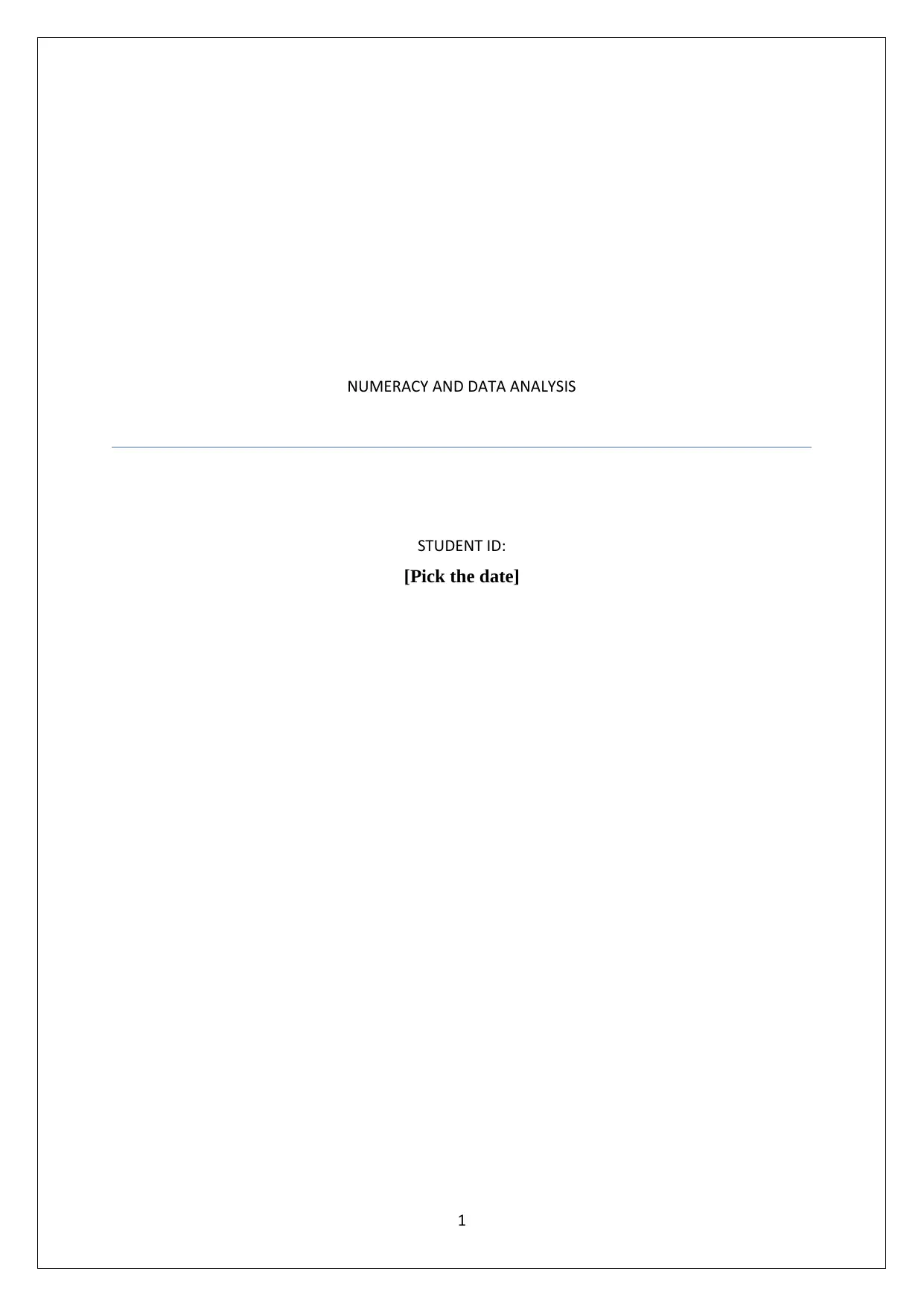
NUMERACY AND DATA ANALYSIS
STUDENT ID:
[Pick the date]
1
STUDENT ID:
[Pick the date]
1
Paraphrase This Document
Need a fresh take? Get an instant paraphrase of this document with our AI Paraphraser
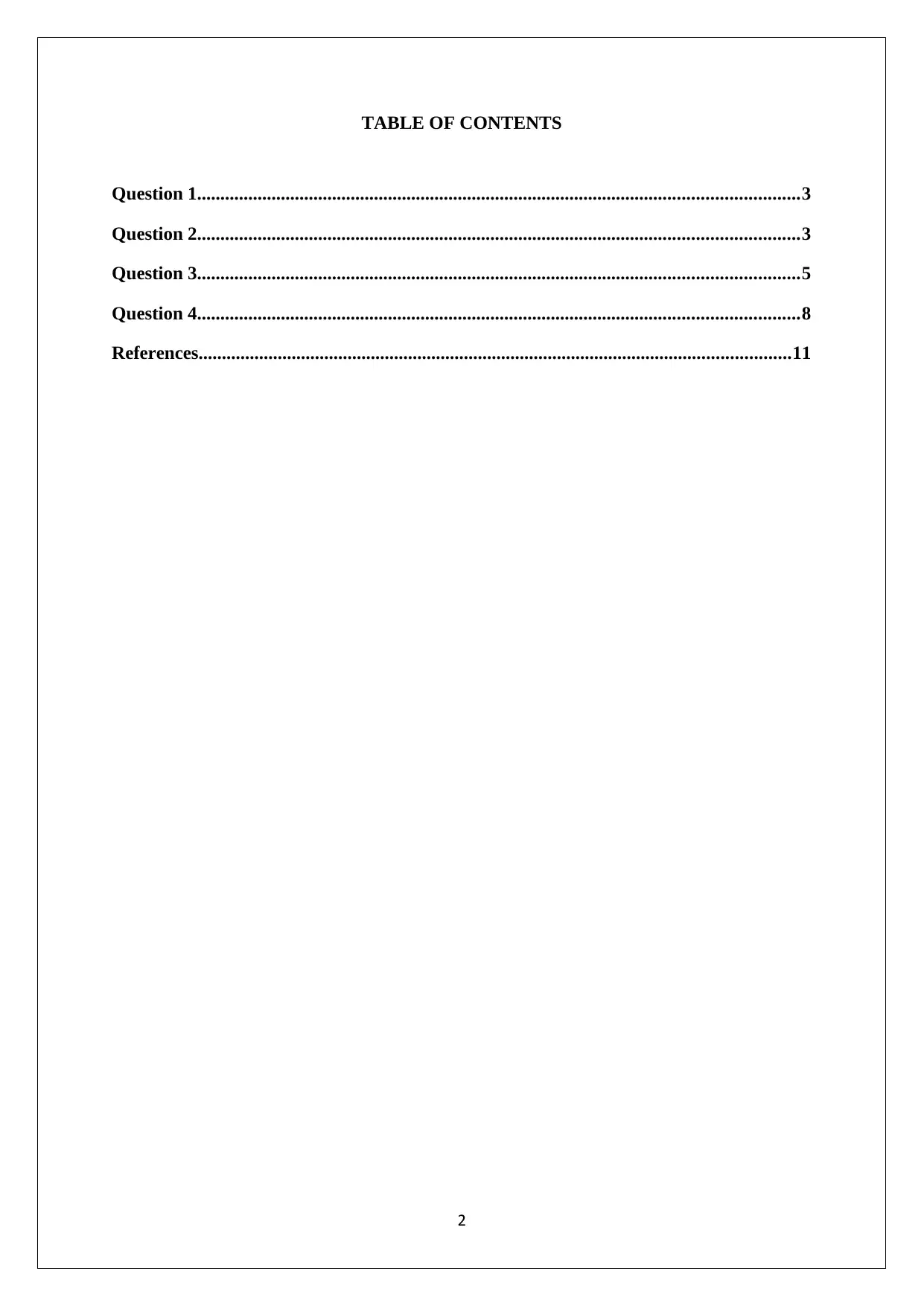
TABLE OF CONTENTS
Question 1.................................................................................................................................3
Question 2.................................................................................................................................3
Question 3.................................................................................................................................5
Question 4.................................................................................................................................8
References...............................................................................................................................11
2
Question 1.................................................................................................................................3
Question 2.................................................................................................................................3
Question 3.................................................................................................................................5
Question 4.................................................................................................................................8
References...............................................................................................................................11
2
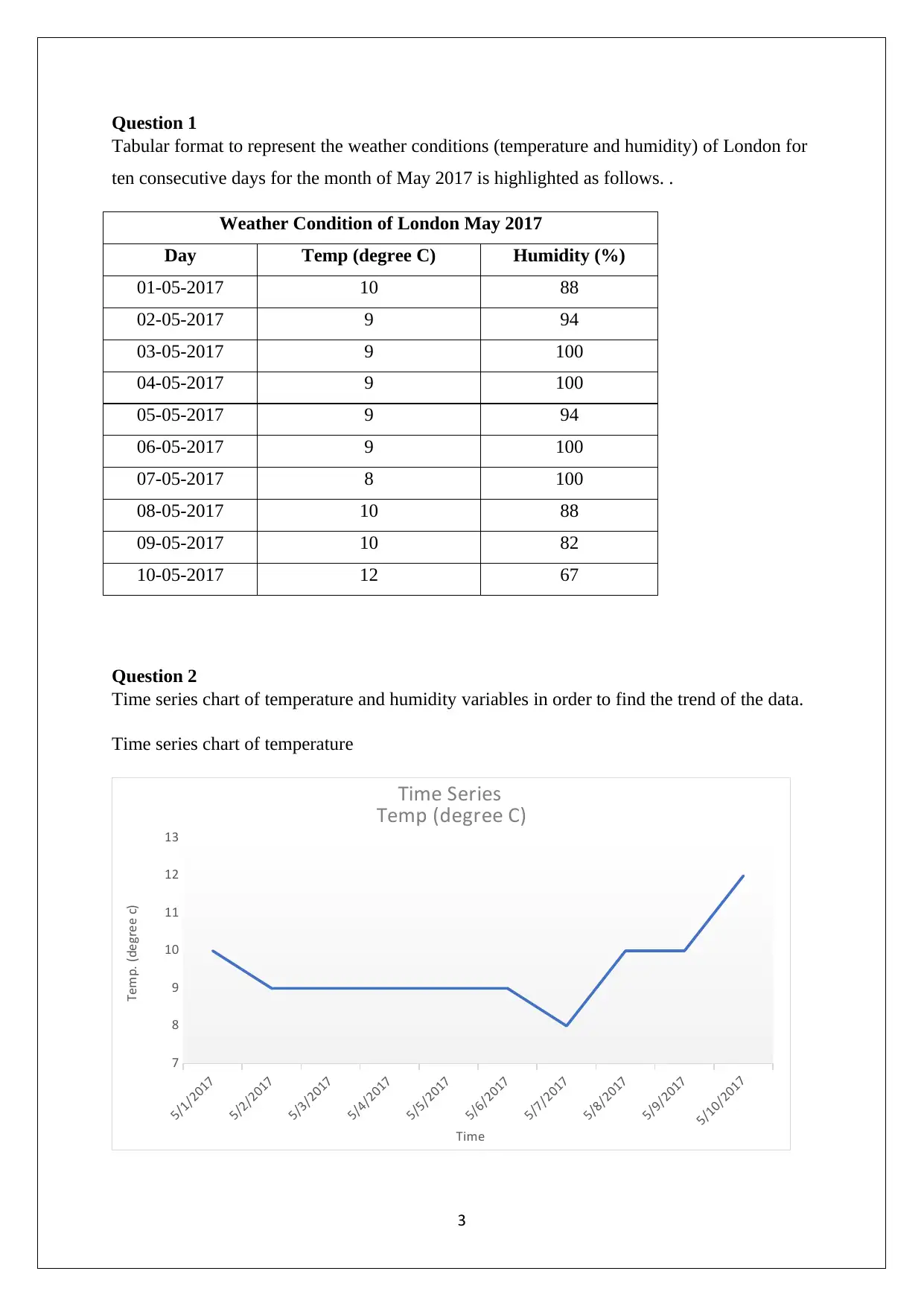
Question 1
Tabular format to represent the weather conditions (temperature and humidity) of London for
ten consecutive days for the month of May 2017 is highlighted as follows. .
Weather Condition of London May 2017
Day Temp (degree C) Humidity (%)
01-05-2017 10 88
02-05-2017 9 94
03-05-2017 9 100
04-05-2017 9 100
05-05-2017 9 94
06-05-2017 9 100
07-05-2017 8 100
08-05-2017 10 88
09-05-2017 10 82
10-05-2017 12 67
Question 2
Time series chart of temperature and humidity variables in order to find the trend of the data.
Time series chart of temperature
5/1/2017
5/2/2017
5/3/2017
5/4/2017
5/5/2017
5/6/2017
5/7/2017
5/8/2017
5/9/2017
5/10/2017
7
8
9
10
11
12
13
Time Series
Temp (degree C)
Time
Temp. (degree c)
3
Tabular format to represent the weather conditions (temperature and humidity) of London for
ten consecutive days for the month of May 2017 is highlighted as follows. .
Weather Condition of London May 2017
Day Temp (degree C) Humidity (%)
01-05-2017 10 88
02-05-2017 9 94
03-05-2017 9 100
04-05-2017 9 100
05-05-2017 9 94
06-05-2017 9 100
07-05-2017 8 100
08-05-2017 10 88
09-05-2017 10 82
10-05-2017 12 67
Question 2
Time series chart of temperature and humidity variables in order to find the trend of the data.
Time series chart of temperature
5/1/2017
5/2/2017
5/3/2017
5/4/2017
5/5/2017
5/6/2017
5/7/2017
5/8/2017
5/9/2017
5/10/2017
7
8
9
10
11
12
13
Time Series
Temp (degree C)
Time
Temp. (degree c)
3
⊘ This is a preview!⊘
Do you want full access?
Subscribe today to unlock all pages.

Trusted by 1+ million students worldwide
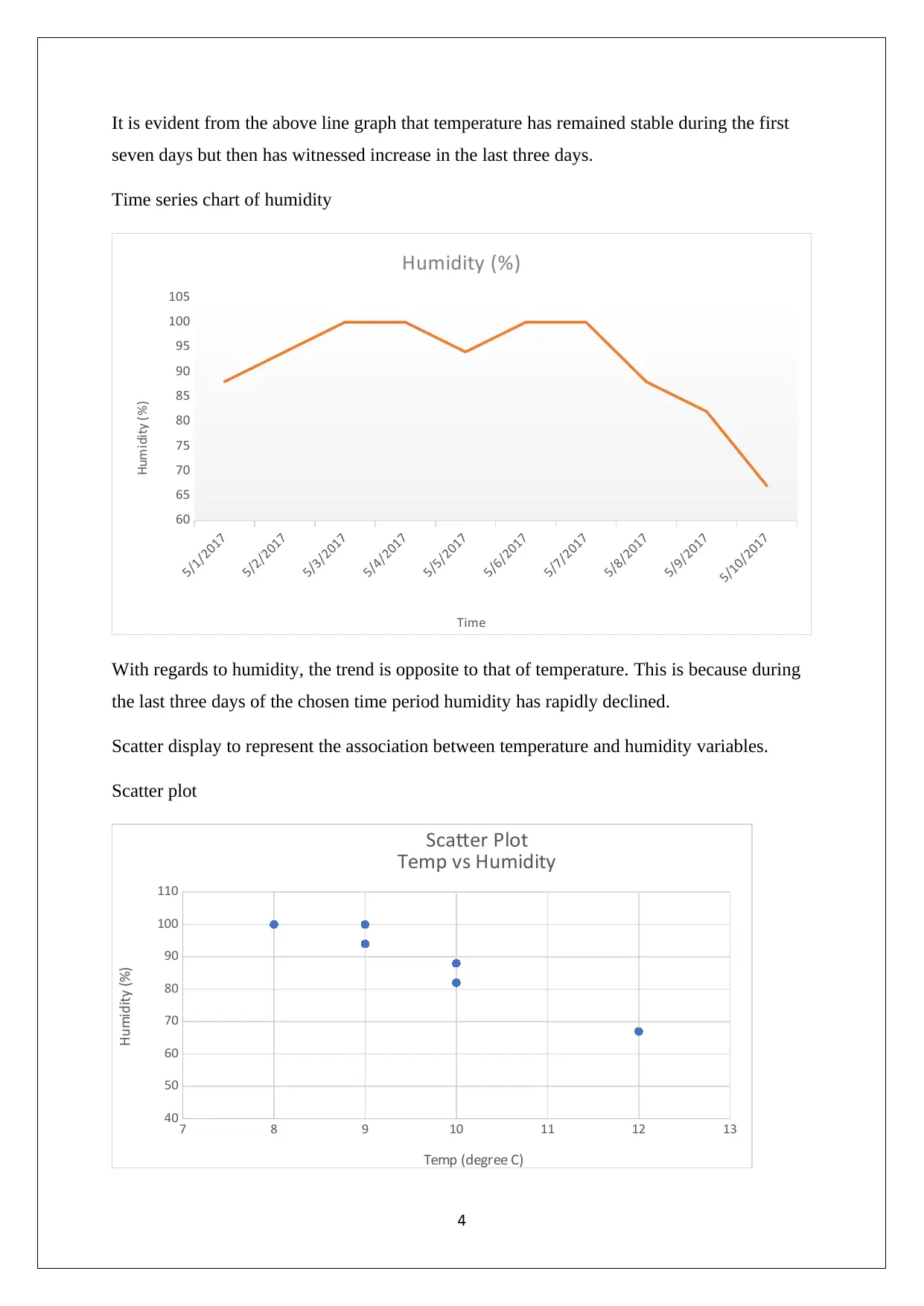
It is evident from the above line graph that temperature has remained stable during the first
seven days but then has witnessed increase in the last three days.
Time series chart of humidity
5/1/2017
5/2/2017
5/3/2017
5/4/2017
5/5/2017
5/6/2017
5/7/2017
5/8/2017
5/9/2017
5/10/2017
60
65
70
75
80
85
90
95
100
105
Humidity (%)
Time
Humidity (%)
With regards to humidity, the trend is opposite to that of temperature. This is because during
the last three days of the chosen time period humidity has rapidly declined.
Scatter display to represent the association between temperature and humidity variables.
Scatter plot
7 8 9 10 11 12 13
40
50
60
70
80
90
100
110
Scatter Plot
Temp vs Humidity
Temp (degree C)
Humidity (%)
4
seven days but then has witnessed increase in the last three days.
Time series chart of humidity
5/1/2017
5/2/2017
5/3/2017
5/4/2017
5/5/2017
5/6/2017
5/7/2017
5/8/2017
5/9/2017
5/10/2017
60
65
70
75
80
85
90
95
100
105
Humidity (%)
Time
Humidity (%)
With regards to humidity, the trend is opposite to that of temperature. This is because during
the last three days of the chosen time period humidity has rapidly declined.
Scatter display to represent the association between temperature and humidity variables.
Scatter plot
7 8 9 10 11 12 13
40
50
60
70
80
90
100
110
Scatter Plot
Temp vs Humidity
Temp (degree C)
Humidity (%)
4
Paraphrase This Document
Need a fresh take? Get an instant paraphrase of this document with our AI Paraphraser
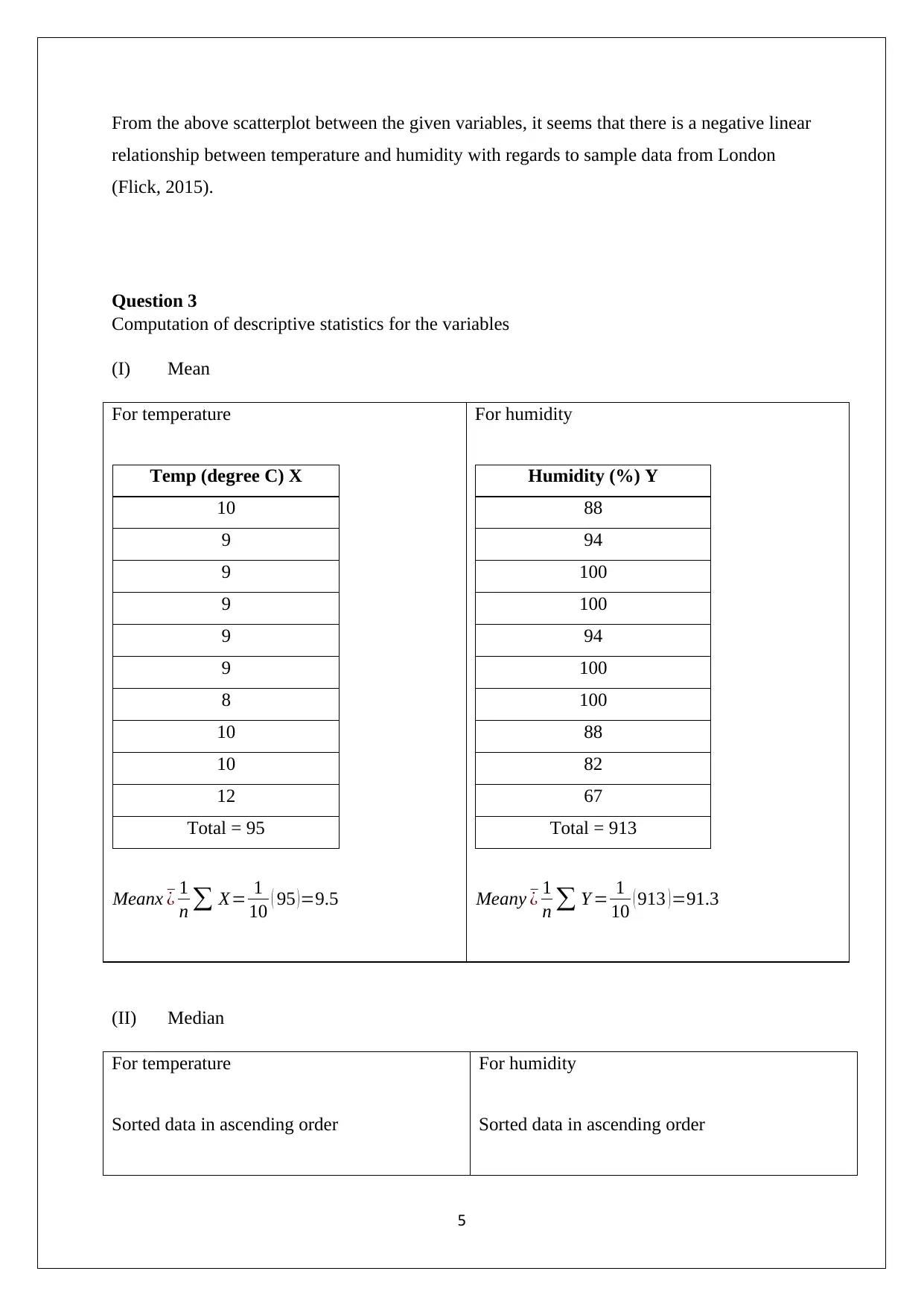
From the above scatterplot between the given variables, it seems that there is a negative linear
relationship between temperature and humidity with regards to sample data from London
(Flick, 2015).
Question 3
Computation of descriptive statistics for the variables
(I) Mean
For temperature
Temp (degree C) X
10
9
9
9
9
9
8
10
10
12
Total = 95
Meanx ¯¿ 1
n ∑ X= 1
10 ( 95 )=9.5
For humidity
Humidity (%) Y
88
94
100
100
94
100
100
88
82
67
Total = 913
Meany ¯¿ 1
n ∑ Y = 1
10 ( 913 )=91.3
(II) Median
For temperature
Sorted data in ascending order
For humidity
Sorted data in ascending order
5
relationship between temperature and humidity with regards to sample data from London
(Flick, 2015).
Question 3
Computation of descriptive statistics for the variables
(I) Mean
For temperature
Temp (degree C) X
10
9
9
9
9
9
8
10
10
12
Total = 95
Meanx ¯¿ 1
n ∑ X= 1
10 ( 95 )=9.5
For humidity
Humidity (%) Y
88
94
100
100
94
100
100
88
82
67
Total = 913
Meany ¯¿ 1
n ∑ Y = 1
10 ( 913 )=91.3
(II) Median
For temperature
Sorted data in ascending order
For humidity
Sorted data in ascending order
5
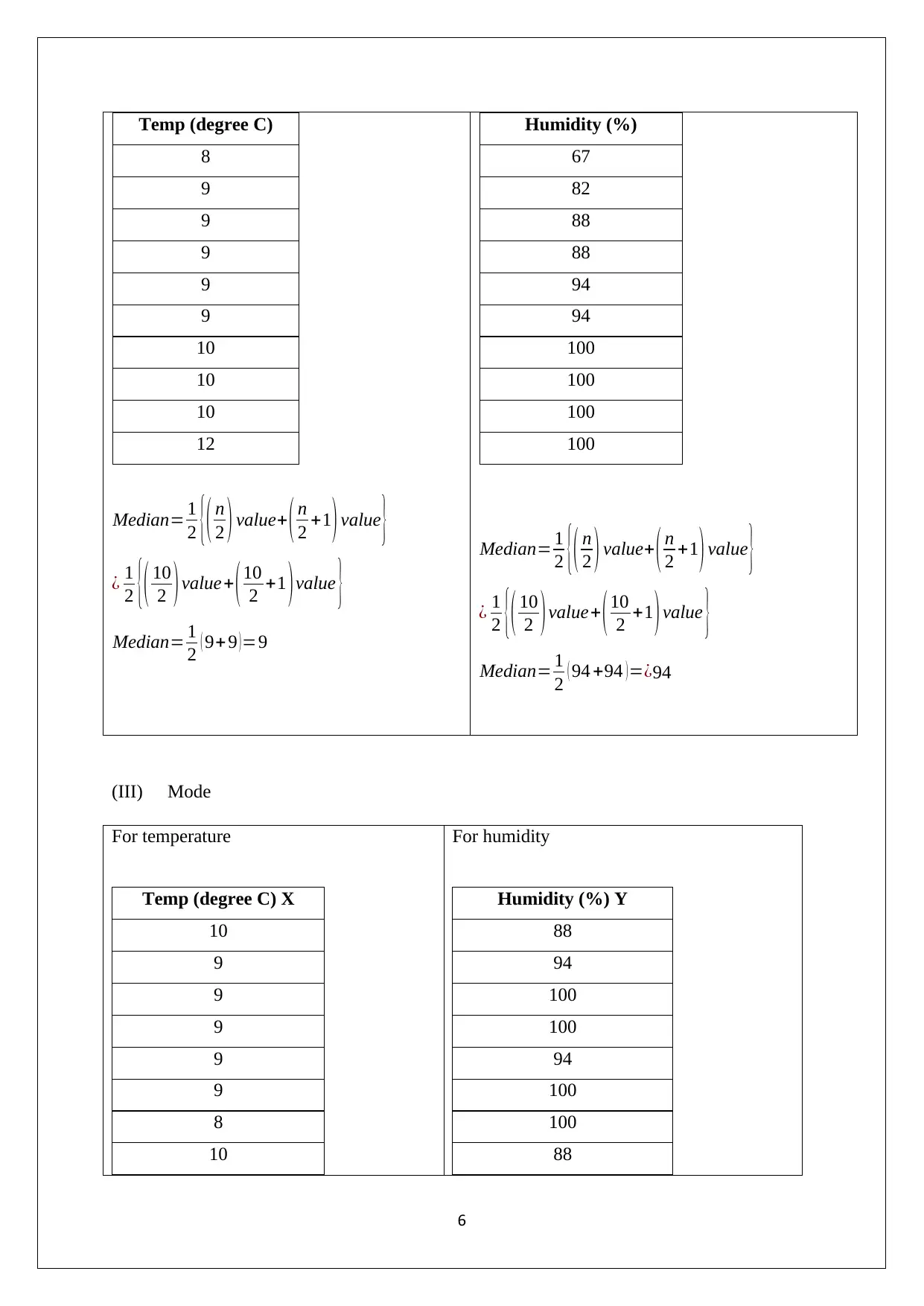
Temp (degree C)
8
9
9
9
9
9
10
10
10
12
Median= 1
2 {( n
2 ) value+ ( n
2 +1) value }
¿ 1
2 {( 10
2 ) value+ ( 10
2 +1 ) value }
Median= 1
2 ( 9+9 )=9
Humidity (%)
67
82
88
88
94
94
100
100
100
100
Median= 1
2 {( n
2 ) value+ ( n
2 +1 ) value }
¿ 1
2 {( 10
2 ) value+ ( 10
2 +1 ) value }
Median= 1
2 ( 94 +94 )=¿94
(III) Mode
For temperature
Temp (degree C) X
10
9
9
9
9
9
8
10
For humidity
Humidity (%) Y
88
94
100
100
94
100
100
88
6
8
9
9
9
9
9
10
10
10
12
Median= 1
2 {( n
2 ) value+ ( n
2 +1) value }
¿ 1
2 {( 10
2 ) value+ ( 10
2 +1 ) value }
Median= 1
2 ( 9+9 )=9
Humidity (%)
67
82
88
88
94
94
100
100
100
100
Median= 1
2 {( n
2 ) value+ ( n
2 +1 ) value }
¿ 1
2 {( 10
2 ) value+ ( 10
2 +1 ) value }
Median= 1
2 ( 94 +94 )=¿94
(III) Mode
For temperature
Temp (degree C) X
10
9
9
9
9
9
8
10
For humidity
Humidity (%) Y
88
94
100
100
94
100
100
88
6
⊘ This is a preview!⊘
Do you want full access?
Subscribe today to unlock all pages.

Trusted by 1+ million students worldwide
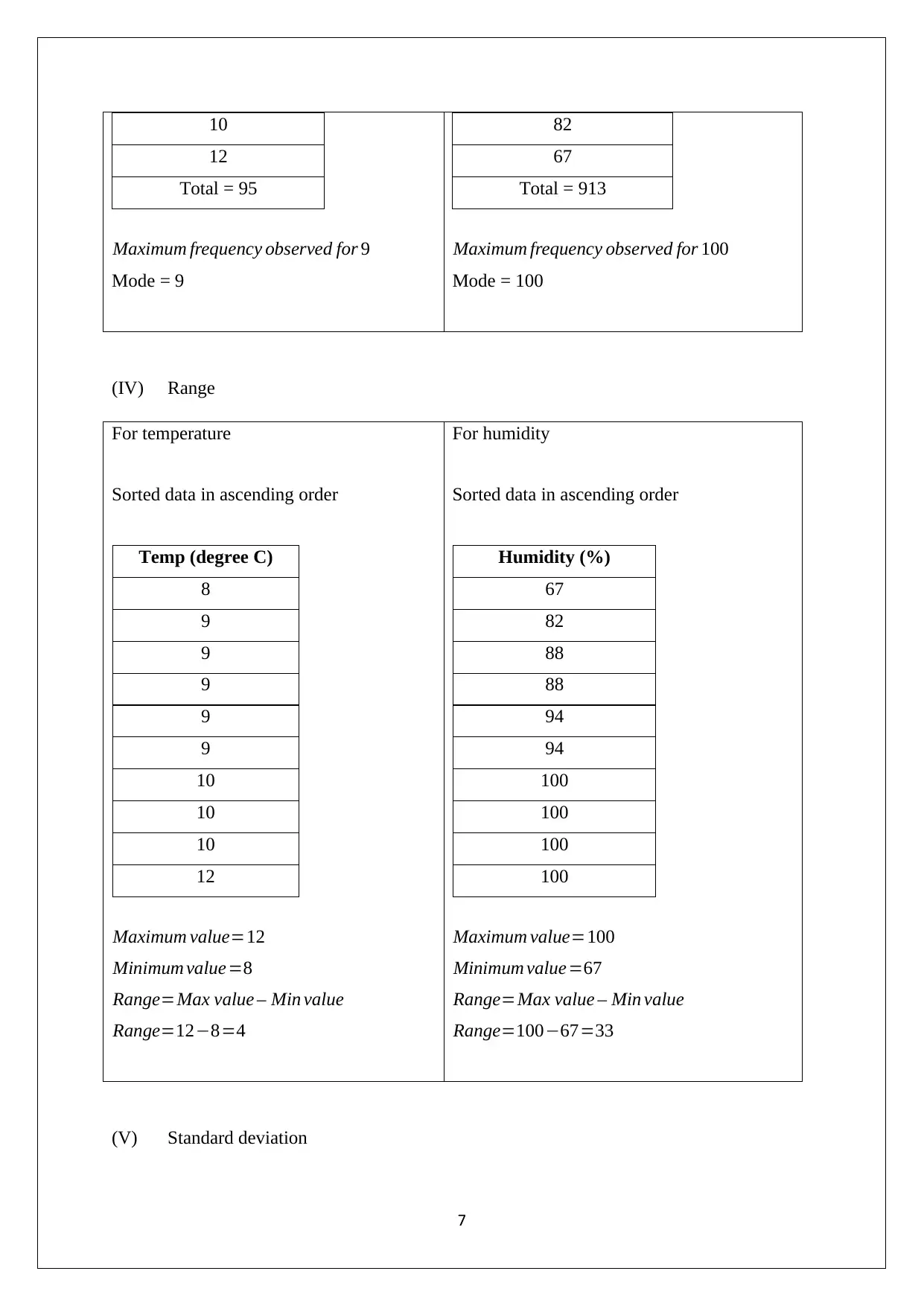
10
12
Total = 95
Maximum frequency observed for 9
Mode = 9
82
67
Total = 913
Maximum frequency observed for 100
Mode = 100
(IV) Range
For temperature
Sorted data in ascending order
Temp (degree C)
8
9
9
9
9
9
10
10
10
12
Maximum value=12
Minimum value =8
Range=Max value – Min value
Range=12−8=4
For humidity
Sorted data in ascending order
Humidity (%)
67
82
88
88
94
94
100
100
100
100
Maximum value=100
Minimum value=67
Range=Max value – Min value
Range=100−67=33
(V) Standard deviation
7
12
Total = 95
Maximum frequency observed for 9
Mode = 9
82
67
Total = 913
Maximum frequency observed for 100
Mode = 100
(IV) Range
For temperature
Sorted data in ascending order
Temp (degree C)
8
9
9
9
9
9
10
10
10
12
Maximum value=12
Minimum value =8
Range=Max value – Min value
Range=12−8=4
For humidity
Sorted data in ascending order
Humidity (%)
67
82
88
88
94
94
100
100
100
100
Maximum value=100
Minimum value=67
Range=Max value – Min value
Range=100−67=33
(V) Standard deviation
7
Paraphrase This Document
Need a fresh take? Get an instant paraphrase of this document with our AI Paraphraser
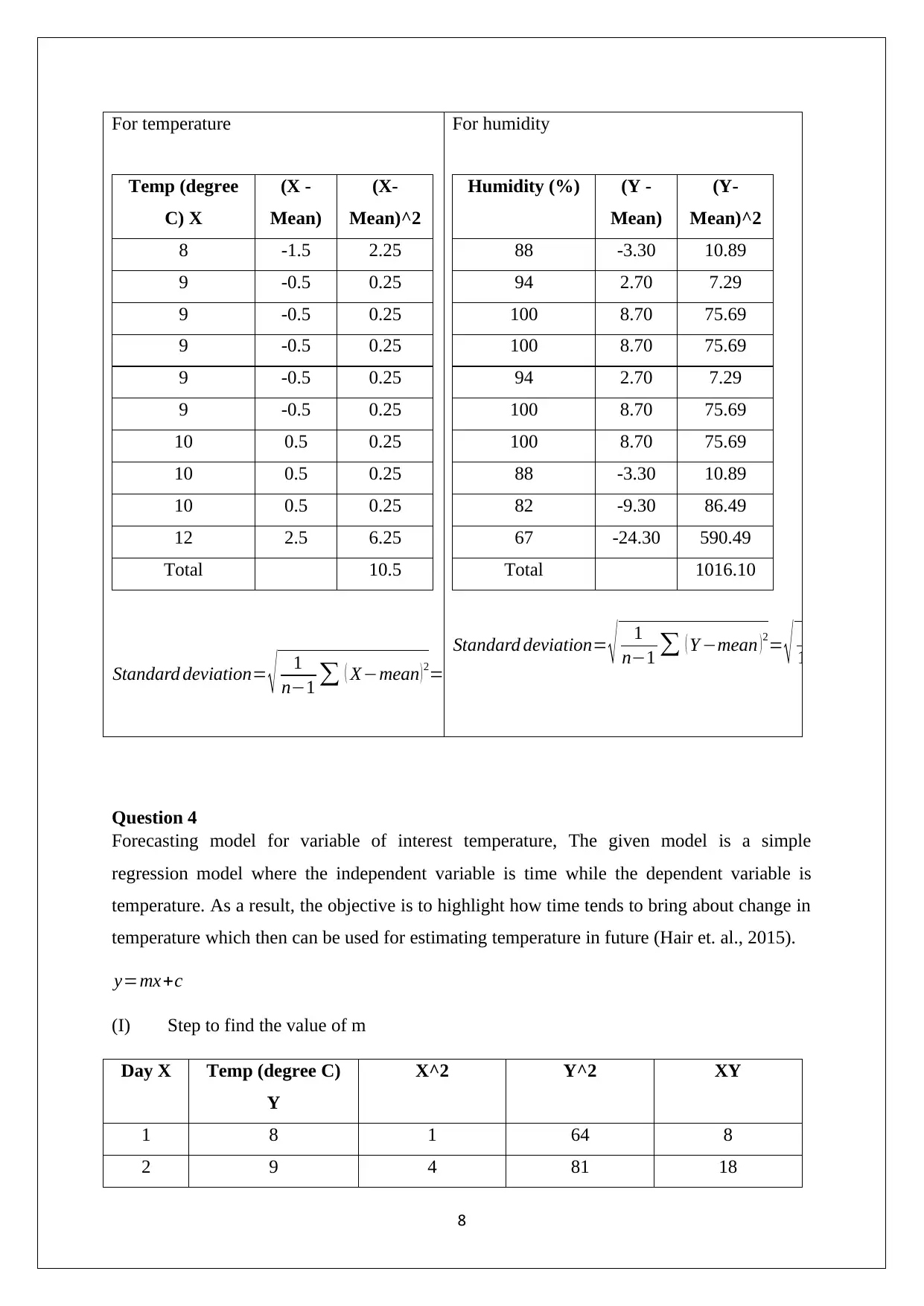
For temperature
Temp (degree
C) X
(X -
Mean)
(X-
Mean)^2
8 -1.5 2.25
9 -0.5 0.25
9 -0.5 0.25
9 -0.5 0.25
9 -0.5 0.25
9 -0.5 0.25
10 0.5 0.25
10 0.5 0.25
10 0.5 0.25
12 2.5 6.25
Total 10.5
Standard deviation= √ 1
n−1 ∑ ( X−mean )2= √ 1
10−1 10.5=1.080
For humidity
Humidity (%) (Y -
Mean)
(Y-
Mean)^2
88 -3.30 10.89
94 2.70 7.29
100 8.70 75.69
100 8.70 75.69
94 2.70 7.29
100 8.70 75.69
100 8.70 75.69
88 -3.30 10.89
82 -9.30 86.49
67 -24.30 590.49
Total 1016.10
Standard deviation= √ 1
n−1 ∑ ( Y −mean ) 2= √ 1
10−1 1016.10=1
Question 4
Forecasting model for variable of interest temperature, The given model is a simple
regression model where the independent variable is time while the dependent variable is
temperature. As a result, the objective is to highlight how time tends to bring about change in
temperature which then can be used for estimating temperature in future (Hair et. al., 2015).
y=mx+c
(I) Step to find the value of m
Day X Temp (degree C)
Y
X^2 Y^2 XY
1 8 1 64 8
2 9 4 81 18
8
Temp (degree
C) X
(X -
Mean)
(X-
Mean)^2
8 -1.5 2.25
9 -0.5 0.25
9 -0.5 0.25
9 -0.5 0.25
9 -0.5 0.25
9 -0.5 0.25
10 0.5 0.25
10 0.5 0.25
10 0.5 0.25
12 2.5 6.25
Total 10.5
Standard deviation= √ 1
n−1 ∑ ( X−mean )2= √ 1
10−1 10.5=1.080
For humidity
Humidity (%) (Y -
Mean)
(Y-
Mean)^2
88 -3.30 10.89
94 2.70 7.29
100 8.70 75.69
100 8.70 75.69
94 2.70 7.29
100 8.70 75.69
100 8.70 75.69
88 -3.30 10.89
82 -9.30 86.49
67 -24.30 590.49
Total 1016.10
Standard deviation= √ 1
n−1 ∑ ( Y −mean ) 2= √ 1
10−1 1016.10=1
Question 4
Forecasting model for variable of interest temperature, The given model is a simple
regression model where the independent variable is time while the dependent variable is
temperature. As a result, the objective is to highlight how time tends to bring about change in
temperature which then can be used for estimating temperature in future (Hair et. al., 2015).
y=mx+c
(I) Step to find the value of m
Day X Temp (degree C)
Y
X^2 Y^2 XY
1 8 1 64 8
2 9 4 81 18
8
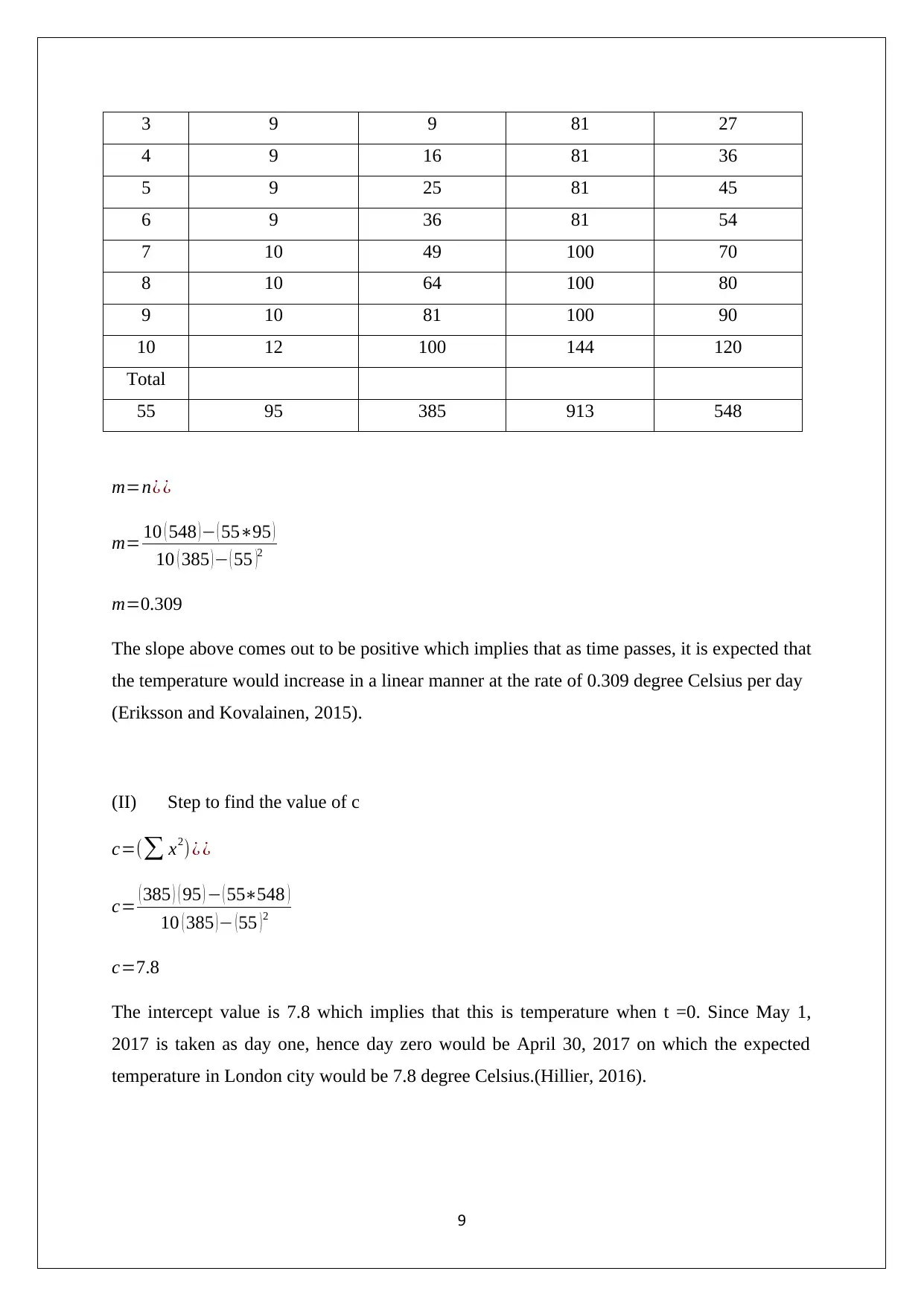
3 9 9 81 27
4 9 16 81 36
5 9 25 81 45
6 9 36 81 54
7 10 49 100 70
8 10 64 100 80
9 10 81 100 90
10 12 100 144 120
Total
55 95 385 913 548
m=n¿ ¿
m= 10 ( 548 ) − ( 55∗95 )
10 ( 385 ) − ( 55 )2
m=0.309
The slope above comes out to be positive which implies that as time passes, it is expected that
the temperature would increase in a linear manner at the rate of 0.309 degree Celsius per day
(Eriksson and Kovalainen, 2015).
(II) Step to find the value of c
c=(∑ x2) ¿ ¿
c= ( 385 ) ( 95 ) − ( 55∗548 )
10 ( 385 )− (55 )2
c=7.8
The intercept value is 7.8 which implies that this is temperature when t =0. Since May 1,
2017 is taken as day one, hence day zero would be April 30, 2017 on which the expected
temperature in London city would be 7.8 degree Celsius.(Hillier, 2016).
9
4 9 16 81 36
5 9 25 81 45
6 9 36 81 54
7 10 49 100 70
8 10 64 100 80
9 10 81 100 90
10 12 100 144 120
Total
55 95 385 913 548
m=n¿ ¿
m= 10 ( 548 ) − ( 55∗95 )
10 ( 385 ) − ( 55 )2
m=0.309
The slope above comes out to be positive which implies that as time passes, it is expected that
the temperature would increase in a linear manner at the rate of 0.309 degree Celsius per day
(Eriksson and Kovalainen, 2015).
(II) Step to find the value of c
c=(∑ x2) ¿ ¿
c= ( 385 ) ( 95 ) − ( 55∗548 )
10 ( 385 )− (55 )2
c=7.8
The intercept value is 7.8 which implies that this is temperature when t =0. Since May 1,
2017 is taken as day one, hence day zero would be April 30, 2017 on which the expected
temperature in London city would be 7.8 degree Celsius.(Hillier, 2016).
9
⊘ This is a preview!⊘
Do you want full access?
Subscribe today to unlock all pages.

Trusted by 1+ million students worldwide
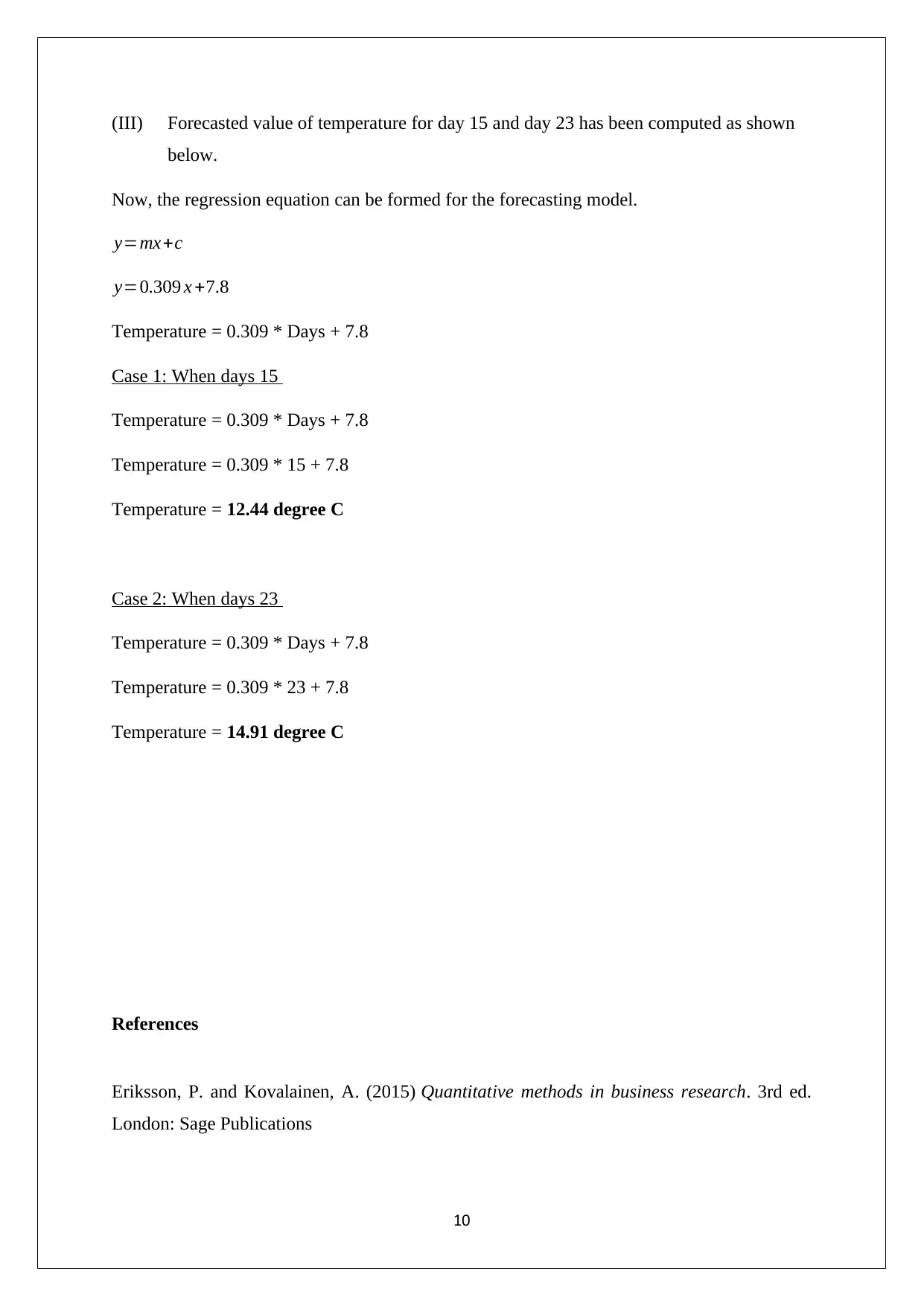
(III) Forecasted value of temperature for day 15 and day 23 has been computed as shown
below.
Now, the regression equation can be formed for the forecasting model.
y=mx+c
y=0.309 x +7.8
Temperature = 0.309 * Days + 7.8
Case 1: When days 15
Temperature = 0.309 * Days + 7.8
Temperature = 0.309 * 15 + 7.8
Temperature = 12.44 degree C
Case 2: When days 23
Temperature = 0.309 * Days + 7.8
Temperature = 0.309 * 23 + 7.8
Temperature = 14.91 degree C
References
Eriksson, P. and Kovalainen, A. (2015) Quantitative methods in business research. 3rd ed.
London: Sage Publications
10
below.
Now, the regression equation can be formed for the forecasting model.
y=mx+c
y=0.309 x +7.8
Temperature = 0.309 * Days + 7.8
Case 1: When days 15
Temperature = 0.309 * Days + 7.8
Temperature = 0.309 * 15 + 7.8
Temperature = 12.44 degree C
Case 2: When days 23
Temperature = 0.309 * Days + 7.8
Temperature = 0.309 * 23 + 7.8
Temperature = 14.91 degree C
References
Eriksson, P. and Kovalainen, A. (2015) Quantitative methods in business research. 3rd ed.
London: Sage Publications
10
Paraphrase This Document
Need a fresh take? Get an instant paraphrase of this document with our AI Paraphraser

Flick, U. (2015) Introducing research methodology: A beginner's guide to doing a research
project. 4th ed. New York: Sage Publications
Hair, J. F., Wolfinbarger, M., Money, A. H., Samouel, P., and Page, M. J. (2015) Essentials
of business research methods. 2nd ed. New York: Routledge
Hillier, F. (2016) Introduction to Operations Research.6th ed.New York: McGraw Hill
Publications,
11
project. 4th ed. New York: Sage Publications
Hair, J. F., Wolfinbarger, M., Money, A. H., Samouel, P., and Page, M. J. (2015) Essentials
of business research methods. 2nd ed. New York: Routledge
Hillier, F. (2016) Introduction to Operations Research.6th ed.New York: McGraw Hill
Publications,
11
1 out of 11
Related Documents
Your All-in-One AI-Powered Toolkit for Academic Success.
+13062052269
info@desklib.com
Available 24*7 on WhatsApp / Email
![[object Object]](/_next/static/media/star-bottom.7253800d.svg)
Unlock your academic potential
Copyright © 2020–2025 A2Z Services. All Rights Reserved. Developed and managed by ZUCOL.





